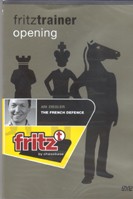For some weird reason, studying the endgame seems to be the bane of many a chessplayer’s existence. Quite a few of my chess friends, competitors, and co-conspirators would rather eat a ten pound bag of lawn clippings raw than spend an hour studying the endgame.
The endgame doesn’t seem to enjoy the same luster, romance, or allure as other phases of the game. Openings have names, sometimes exotic (and violent), like the “Nimzo-Indian Defense” or the “Max Lange Attack”; even the “Fried Liver” seems to have more appeal than the average endgame. Middlegame themes often have names too, whether we’re referring to tactics like “pins”, “forks”, and “skewers”, or structural motifs such as “the Maroczy Bind”. But endgames? The names tend to be rather humdrum descriptions of what remains on the board: “King and pawn ending” or “Queen vs. Rook”.
Maybe it’s because the endgame isn’t as “structured” as the opening. At the start of a game of chess the pieces always begin on the same squares, making the rote memorization of variations possible (though not necessarily desirable; we’ll come back to this in a later post). With endgames, you have to learn specific techniques — but they’re procedures which won’t apply in every single endgame; you have to decide “on the fly” (that is, during the game) which ones, if any, apply.
Perhaps there are more reasons for “endgame aversion”; they may be as numerous and varied as the number of chessplayers out there. But the fact remains: no one becomes a competent (much less “good”) player without studying the chess endgame.
It’s a fact and plenty of strong players will tell you so. Sure, it’s possible to become maybe halfway decent (perhaps through dumb luck?) without paying any mind to the ending: a Class A player of my acquaintance still scoffs at the importance of endgames. But I’ve seen him drop many a rating point to Class B through D players who manage to make it to an even endgame with him and then outplay him. Those are points he needn’t have lost if he’d just spent a little time working on basic endgame technique. Speaking from my own experience, I became a much better endgame player after studying only the simple King-and-pawn endgames. I could quickly look at a late middlegame position and decide whether or not swapping pieces down to the endgame would be to my advantage simply by looking at the current pawn structure. I beat some much more highly rated players this way merely by knowing, understanding, and recognizing a few simple King-and-pawn endings and how to play them.
So here’s today’s tip — and it’s a big one:
4. Study chess endgames
Nobody’s saying that you must devote many hours a week to studying all kinds of endgames; that obviously wouldn’t hurt, but it’s not strictly necessary. Begin with the basics — start with simple mates against a lone King. You would be amazed by the number of Class C and D players I encounter who don’t know how to mate with one Rook and King against a lone King (and I once won a nice-sized pub bet by demonstrating this mate against a guy who insisted that “it couldn’t be done” with one Rook).
After you’ve mastered the various mating patterns against a lone King, move on to various King and pawn endings — just Kings and pawns, no pieces. This is an area which really helped my game (as I stated previously). If you spend as little as a hour a day for just a week or two studying King and pawn endings, plus practice applying what you’ve learned to your own games, I guarantee you’ll quickly become a believer in the power of the endgame.
4. Study chess endgames
With the possible exception of Tip #1, this is arguably the most important tip so far — primarily because it’s the one which most chessplayers seem inclined to ignore. Trust me — you do so at your own peril. Don’t be like my Class A friend who gets skunked by a Class D in an endgame he should have won, then wonders what went wrong and where those precious rating points went. Once you’ve lost the points, it’s too late. This is definitely one area in which the old cliché applies: an ounce of prevention is worth a pound of cure.
ChessCentral offers quite a few study materials on the chess endgame. For basic endgame study I recommend the ChessBase CD The ABCs of Endgames. For pure pawn endings, the FritzTrainer on that subject is also quite good. If you’re looking for a more complete guide to the endgame, the modern-day classic Dvoretsky’s Endgame Manual is available in both print and electronic forms.
Have fun! — Steve
Filed under: Chess instruction, Chess Software | Tagged: chess, chess dvd, chess endgame, chess improvement, Chess instruction, chess products, chess program, Chess Software, chess training, chesscentral, Fritz Trainers, program, software | 2 Comments »





